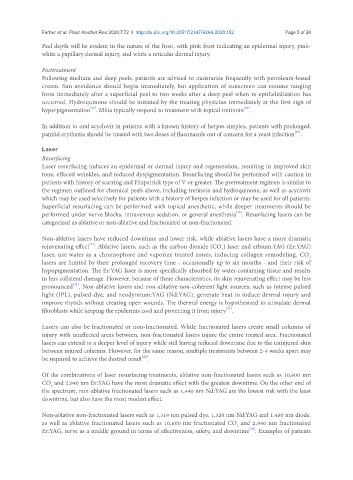Page 855 - Read Online
P. 855
Farber et al. Plast Aesthet Res 2020;7:72 I http://dx.doi.org/10.20517/2347-9264.2020.152 Page 5 of 28
Peel depth will be evident in the nature of the frost, with pink frost indicating an epidermal injury, pink-
white a papillary dermal injury, and white a reticular dermal injury.
Posttreatment
Following medium and deep peels, patients are advised to moisturize frequently with petroleum-based
cream. Sun avoidance should begin immediately, but application of sunscreen can resume ranging
from immediately after a superficial peel to two weeks after a deep peel when re-epithelialization has
occurred. Hydroquinone should be initiated by the treating physician immediately at the first sign of
[22]
[23]
hyperpigmentation . Milia typically respond to treatment with topical tretinoin .
In addition to oral acyclovir in patients with a known history of herpes simplex, patients with prolonged,
painful erythema should be treated with two doses of fluconazole out of concern for a yeast infection .
[24]
Laser
Resurfacing
Laser resurfacing induces an epidermal or dermal injury and regeneration, resulting in improved skin
tone, effaced wrinkles, and reduced dyspigmentation. Resurfacing should be performed with caution in
patients with history of scarring and Fitzpatrick type of V or greater. The pretreatment regimen is similar to
the regimen outlined for chemical peels above, including tretinoin and hydroquinone, as well as acyclovir
which may be used selectively for patients with a history of herpes infection or may be used for all patients.
Superficial resurfacing can be performed with topical anesthetic, while deeper treatments should be
[25]
performed under nerve blocks, intravenous sedation, or general anesthesia . Resurfacing lasers can be
categorized as ablative or non-ablative and fractionated or non-fractionated.
Non-ablative lasers have reduced downtime and lower risk, while ablative lasers have a more dramatic
rejuvenating effect . Ablative lasers, such as the carbon dioxide (CO ) laser and erbium:YAG (Er:YAG)
[21]
2
laser, use water as a chromophore and vaporize treated zones, inducing collagen remodeling. CO
2
lasers are limited by their prolonged recovery time - occasionally up to six months - and their risk of
hypopigmentation. The Er:YAG laser is more specifically absorbed by water-containing tissue and results
in less collateral damage. However, because of these characteristics, its skin rejuvenating effect may be less
[21]
pronounced . Non-ablative lasers and non-ablative non-coherent light sources, such as intense pulsed
light (IPL), pulsed-dye, and neodymium:YAG (Nd:YAG), generate heat to induce dermal injury and
improve rhytids without creating open wounds. The thermal energy is hypothesized to stimulate dermal
[21]
fibroblasts while keeping the epidermis cool and protecting it from injury .
Lasers can also be fractionated or non-fractionated. While fractionated lasers create small columns of
injury with unaffected areas between, non-fractionated lasers injure the entire treated area. Fractionated
lasers can extend to a deeper level of injury while still having reduced downtime due to the uninjured skin
between injured columns. However, for the same reason, multiple treatments between 2-4 weeks apart may
be required to achieve the desired result .
[26]
Of the combinations of laser resurfacing treatments, ablative non-fractionated lasers such as 10,600 nm
CO and 2,940 nm Er:YAG have the most dramatic effect with the greatest downtime. On the other end of
2
the spectrum, non-ablative fractionated lasers such as 1,440 nm Nd:YAG are the lowest risk with the least
downtime, but also have the most modest effect.
Non-ablative non-fractionated lasers such as 1,319 nm pulsed dye, 1,320 nm Nd:YAG and 1,450 nm diode,
as well as ablative fractionated lasers such as 10,600 nm fractionated CO and 2,940 nm fractionated
2
[26]
Er:YAG, serve as a middle ground in terms of effectiveness, safety, and downtime . Examples of patients

